
Groundbreaking Neuroscience Study Reveals Secrets of Eye Movement!
2024-11-25
Author: Sarah
Groundbreaking Neuroscience Study Reveals Secrets of Eye Movement!
In an exciting development that could impact our understanding of vision and related disorders, researchers at Weill Cornell Medicine have successfully decoded the neuronal circuits governing eye movements in zebrafish larvae. The study, published in *Nature Neuroscience* on November 22, unveils a simplified artificial circuit mirroring the brainstem's architecture, predicting how these networks guide the fish's gaze with impressive accuracy.
Watching the behavior of these week-old zebrafish, the research team made significant strides in understanding how brains handle short-term memory. This is no small feat, as maintaining sensory information in a rapidly changing environment is crucial for survival in both animals and humans. For instance, forming coherent thoughts or maintaining focus on prey both hinge on the brain’s ability to keep track of these fleeting sensory signals.
Senior author Emre Aksay, an associate professor at Weill Cornell Medicine, explained, "Our core goal is to understand how these short-term memory behaviors are generated at the level of neural mechanisms." He collaborated with Mark Goldman from the University of California, Davis, and Sebastian Seung from Princeton University to tackle this complex topic.
Using advanced mathematical modeling based on dynamical systems, the researchers explored how neuronal circuits can settle into specific states, linking eye movements to stored memories of where an animal should be looking next. They considered factors such as the anatomical structures of the circuit and the physiological strength of connections between neurons, factors influenced by neurotransmitter types, receptor concentration, and more.
Interestingly, the team chose larval zebrafish for their study due to their simple brain structure, consisting of just 500 neurons—making it feasible to analyze and manipulate the entire circuit structurally and functionally, a challenge in more complex vertebrates.
By employing cutting-edge imaging techniques, they were able to identify the neurons that control the gaze and their wiring. This analysis revealed two significant feedback loops within the circuit formed by tightly connected neuronal clusters. Their computational model closely mirrored the zebrafish’s neural activity patterns, confirming the prediction capabilities of their simplified network. Aksay remarked, "I was amazed at how accurately we could predict circuit behavior based solely on its anatomical architecture."
Moving forward, the researchers plan to investigate how individual cell clusters influence the circuit's behavior, including examining potential genetic signatures that distinguish neurons across different clusters. This knowledge could pave the way for targeted therapies for individuals suffering from eye movement disorders.
What’s more, these findings could serve as a foundational blueprint for understanding more complex computational systems in the brain that rely on short-term memory, such as those involved in visual processing or language comprehension.
Stay tuned for more incredible breakthroughs in neuroscience and their implications for medical science! Will this research change how we approach eye movement disorders? Only time will tell!


 Brasil (PT)
Brasil (PT)
 Canada (EN)
Canada (EN)
 Chile (ES)
Chile (ES)
 España (ES)
España (ES)
 France (FR)
France (FR)
 Hong Kong (EN)
Hong Kong (EN)
 Italia (IT)
Italia (IT)
 日本 (JA)
日本 (JA)
 Magyarország (HU)
Magyarország (HU)
 Norge (NO)
Norge (NO)
 Polska (PL)
Polska (PL)
 Schweiz (DE)
Schweiz (DE)
 Singapore (EN)
Singapore (EN)
 Sverige (SV)
Sverige (SV)
 Suomi (FI)
Suomi (FI)
 Türkiye (TR)
Türkiye (TR)